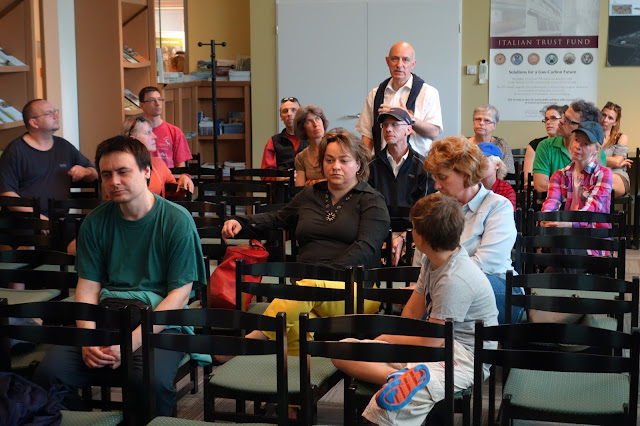 |
| Tarlos, left, is all about charisma and vision. |
He also labeled as "dangerous" the recently introduced system of contraflow bike lanes, and promised to subject them to a review by a secret working group.
Further, Tarlós poured cold water on a marvellous conceptual plan, revealed just this week, that would create a pedestrian-friendly Pest embankment and establish two bike lanes on the Chain Bridge.
The mayor's proposals came during a transport-themed press conference Thursday, outlining, among other things, plans for future transport financing and the city's obligation to introduce congestion charging (no earlier than 2017, he promised).
The Hungarian Cyclists Club reacted in an open letter urging the City Assembly and the councils of Budapest's district governments to reject the proposals. If you'd like to express your personal disgust with these ideas, check the options at the bottom of the link.
The club's letter objected firstly to the closed process in which the proposals were developed. Tarlós said they came from a "working group" whose members weren't identified and who didn't consult with the cyclists club on its cycling provisions. Illiberal democracy in action!
Tarlós's ideas are based on his rejection of a basic principle of cycling development: that routes should be designed to give cyclists the shortest path between points A and B. This is the only way to make cycling practical and attractive as a means of transport. Tarlós complained that the city can't make this an "absolute priority".
Not that it ever has. The cycling movement has campaigned for many years to end the old-fashioned practice of creating circuitous bikeways that snake on sidewalks around hidden side streets. Long-standing campaigns to put bike lanes on the Nagykörút and on Rákóczi út are examples of trying to make cycling convenient and practical, and Tarlos's statement is a clear rejection of these proposals.
Paradoxically, Tarlós's anti-cycling agenda, and assurances of continued car-friendly transport, are wrapped in an overall concept that he calls an "extremely public transport oriented" system. He thinks cycling, the most space-efficient means of transport next to walking, is a main barrier to fast public transport.
This is why the shared bike-lanes need to be removed, he said. He provided no evidence that bikes are holding up buses, while ignoring the actual cause of slow bus service: traffic jams on streets that DON'T have priority transit lanes.
Tarlós called contraflow cycling lanes "dangerous", despite the fact that there have been no serious accidents on them. Contraflow lanes have been a success in cities the world over, not only making cycling more convenient, but actually enhancing safety because they allow for eye-to-eye contact between motorist and cyclist.
Tarlós also cited safety as a justification for operating licenses for cyclists, which he said could be implemented by 2018. He bases the idea, also unsupported, on his assertion that "eight out of ten cyclists run red lights." Tarlós declared: "Cycling culture is not developing at the same rate as cycling infrastructure."
In fact cycling culture has been developing and safety has been improving. Semi-annual observations organised by the movement have shown that more and more cyclists are using lamps after dark, for instance. And the overall incidence of serious road injuries and fatalities among cyclists has decreased in Budapest, in step with the increase in cyclist numbers. This improvement mirrors countless international examples: Promotion of cycling levels is the best way to improve cycling safety.
To cap off his dismal vision for a more retrograde city, Tarlós criticised the most exciting elements of a new development concept for the Pest embankment and Chain Bridge. The plan, focussed on the embankment between the Margit and Szabadság bridges, proposes a mix of motor-traffic reduction and elimination along different segments. Traffic on the Chain Bridge would be reduced to one lane for motor traffic heading toward Buda. The saved space would be given to bike lanes.
But Tarlós was clear in his opposition to the concept: "The city leadership does not plan for one-way traffic on the Chain Bridge or closing traffic on the lower Pest bank."

































